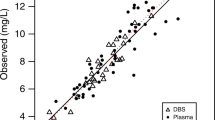Abstract
Cardiopulmonary bypass (CPB) makes prediction of any drug concentration diffcult because both hypothermia and hemodilution can alter the pharmacokinetics of the drug. Eleven patients undergoing cardiac surgery under CPB were anesthetized with continuous infusion of ketamine combined with intermittent administration of droperidol and fentanyl. The infusion rate of ketamine was 2 mg·kg−1·hr−1 following a bolus administration of 1.5 mg·kg−1 for the induction of anesthesia. Blood concentrations of ketamine and its main metabolite, norketamine, were measured at 0, 30, and 60 min after the start of and the end of CPB, and 0, 1, 2, and 24 h after the cessation of ketamine infusion. Hypothermia increased blood ketamine levels during CPB, but the norketamine levels did not change. Although acute hemodilution would decrease blood ketamine levels, their levels were already significantly increased at 30 min after CPB. Hypothermic factors have a more kinetically important role during CPB than hemodilution. Increases in blood norketamine levels following rewarming indicate that hypothermia could impair ketamine metabolism in the liver. Further increase in the plasma concentration of ketamine until 30 min after the end of CPB might be due to blood transfusion containing ketamine from the CPB reservoir.
Similar content being viewed by others
References
Corssen GC, Allarde R, Brosch F, Arbenz G (1970) Ketamine as the sole anesthetic in open-heart surgery: a preliminary report. Anesth Analg 49:1025–1031
Russell GN (1991) Total intravenous anaesthesia and postoperative sedation for cardiac surgery. In: Kay B (ed) Total intravenous anaesthesia. Elsevier, Amsterdam, pp 225–246
Kudo T, Kudo M, Muraoka M, Amano N, Matsuki A (1990) Accurate and simplified determination of ketamine in plasma by gas chromatography mass spectrometry (in Japanese with English abstract). Masui (Jpn J Anesthesiol) 39:81–84
Russell GN, Wright EL, Fox MA, Douglas EJ, Cockshott ID (1989) Propofol-fentanyl anaesthesia for coronary artery surgery and cardiopulmonary bypass. Anaesthesia 44:205–208
Matsuki A, Ishihara H, Kotani N, Takahashi S, Ogasawara A (1991) A clinical study on total intravenous anesthesia with droperidol, fentanyl and ketamine-2. Pharmacokinetics following the end of continuous ketamine infusion- (in Japanese with English abstract). Masui (Jpn J Anesthesiol) 40:61–65
Idvall J, Ahlgren I, Aronsen KF, Stenberg P (1979) Ketamine infusion: pharmacokinetics and clinical effects. Br J Anaesth 51:1167–1173
Little B, Chang T, Chucot L, Dill WA, Enrile LL, Glazko AJ, Jassani M, Kretchmer H, Sweet AY (1972) Study of ketamine as an obstetric anesthetic agent. Am J Obstet Gynecol 113: 247
Goto T (1986) Effect on hypotension anesthesia on hepatic blood flow and hepatic metabolism (in Japanese with English abstract). Masui (Jpn J Anesthesiol) 35:411–421
Aono J, Takeda A, Ueda W, Hirakawa M (1990) Interaction of halothane and PGE1 on ICG excretion (in Japanese with English abstract). Masui (Jpn J Anesthesiol) 39:588–591
Hayakawa J, Suzuki H, Yoshida G, Osuda Y, Numata K (1990) Effect of induced hypotension on arterial blood ketone body ratio (AKBR) (in Japanese with English abstract). Masui (Jpn J Anesthesiol) 39:459–464
Stachura J, Tarnawski A, Ivey K, Mach T, Bogdal J, Szczudrawa J, Klimczyk B (1981) Prostaglandin protection of carbon tetrachloride-induced liver cell necrosis in the rat. Gastroenterology 81:211–217
Stoeling RK (1991) Nonbarbiturate induction drugs. In: Stoeling RK (ed) Pharmacology and physiology in anesthetic practice. Lippincott, Philadelphia, pp 134–147
Author information
Authors and Affiliations
About this article
Cite this article
Hirota, K., Wakayama, S., Sugihara, K. et al. Pharmacokinetics of ketamine during hypothermic cardiopulmonary bypass in cardiac patients. J Anesth 9, 142–145 (1995). https://doi.org/10.1007/BF02479845
Received:
Accepted:
Issue Date:
DOI: https://doi.org/10.1007/BF02479845




